How 6,500 People Lit an Incredible 360° Nighttime Panorama of an NFL Stadium
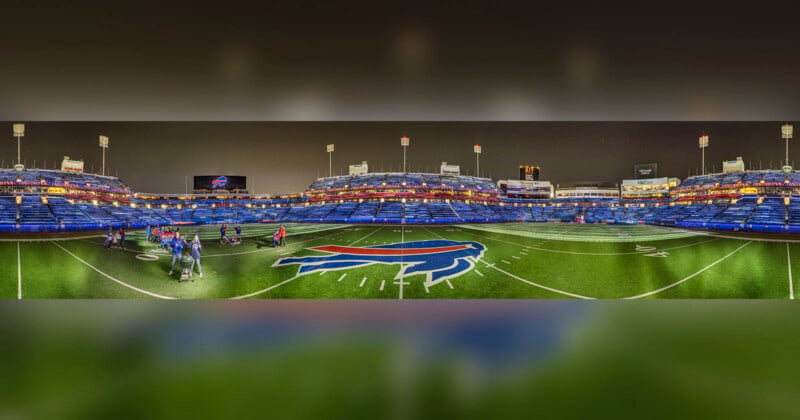
RIT Big Shot 37 at Highmark Stadium in Buffalo, New York, was the biggest light painting photo in the series yet, attracting approximately 6,500 Buffalo Bills fans, RIT alumni, and Western New York locals to the historic stadium during its final season. The incredible 360° Big Shot was the result meticulous planning, two dozen Nikon Z9 cameras, and thousands of people armed with flashlights joining forces to bathe a massive football stadium in light.
Big Shot: From Humble Beginnings to Globe-Trotting Panorama Adventures
RIT Big Shot, which is run by the College of Art and Design at Rochester Institute of Technology, was started in 1987 by RIT’s Michael Peres, Bill DuBois, and Dawn Tower DuBois as a fun way to teach RIT students studying biomedical photographic communications about photographic problem solving. While they have all since retired, their Big Shot legacy lives on.
The very first subject in 1987 was the Highland Hospital in Rochester, New York. The following year, the team of teachers and students captured the famous George Eastman Museum. Big Shot stayed in Rochester, New York for many years, before venturing outside the city to the beautiful Ontario County Courthouse in Canandaigua, New York.
Once that geographic barrier had been broken, all bets were off. Big Shot 14 went to the Intrepid Museum in New York City, Big Shot 16 took on The Alamo, Big Shot 20 captured a light-painted panorama of The Royal Palace in Stockholm, Big Shot 23 went to Pile Gate in Croatia, and Big Shot 28 in 2012 captured a great shot of Cowboys Stadium outside of Dallas.
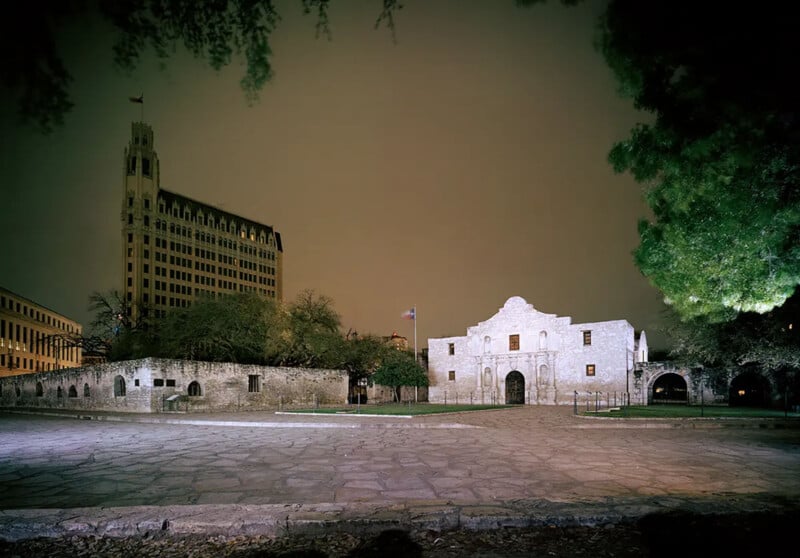
Big Shot 37’s short trip west from Rochester to Highmark Stadium in Orchard Park, New York, just outside Buffalo, is timely. Right across the street, the “New Highmark Stadium,” a $2.2 billion 67,000-capacity state-of-the-art stadium nears its completion. The stadium is scheduled to open for kickoff in 2026. This means the current Highmark Stadium, opened in 1973, will be demolished and turned into parking.
This is the final season for the Buffalo Bills in the stadium they called home for over 50 years. Multiple generations of Bills fans have shoveled feet of snow off their seats, tail gated for hours before game time, and body-slammed countless tables. Bills fans are a passionate bunch who stick with their team through thick and thin, and the old-school stadium’s aging concrete is the foundation upon which many memories, the highs and many lows of being a sports fan, have been built. Like so many other sport’s stadiums, Highmark Stadium, formerly known as Rich Stadium, Ralph Wilson Stadium, New Era Field, and for one season, Bills Stadium, matters a lot to people.
And that’s why about 6,500 Bills fans showed up on a Saturday night in October to volunteer their time and efforts to help the RIT Big Shot team nail an exceptionally complicated 360-degree light-painted panorama of the entire stadium. This is community-based photography at its very best, and one hell of a technical accomplishment.
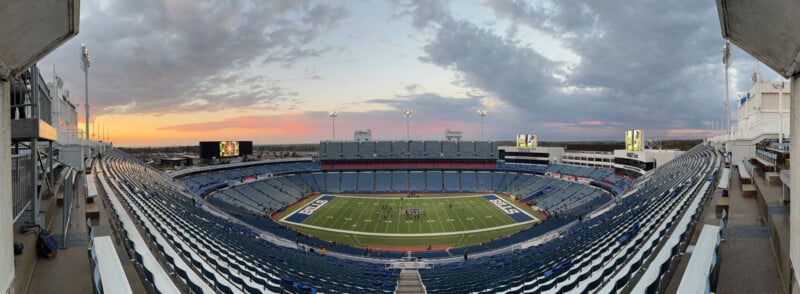
The Setup: 24 Nikon Z9 Cameras On a Custom Rig
360° panoramas are tricky in the most ideal conditions. 360° panoramas at night with thousands of people working in unison, armed with flashlights, to perfectly light an entire football stadium? That’s very ambitious.
The backbone of the entire shot is a custom-built metal rig, which comprises three interconnected metal arms and legs built by Mccrae Industries in Rochester, New York. The custom rig has precisely-spaced points on which to mount 24 Nikon Z9 cameras, each paired with a Nikkor Z 20mm f/1.8 S wide-angle prime lens. These cameras all shoot simultaneously, each capturing a specific portion of the 360-degree scene. The rig was set up just offset from the center of the field so that the Buffalo Bills logo would appear in the frame.
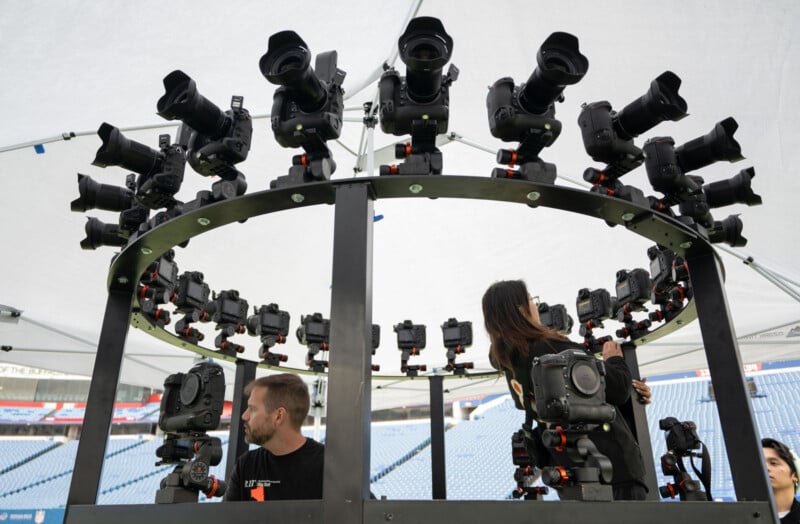
Stitching 24 45.7-megapixel long-exposure shots into a 360-degree panorama is no small task, so it needed to be handled by PTGui, a specialized image stitching application. In prior years, the Big Shot team used more standard software, like Adobe Photoshop, for stitching.
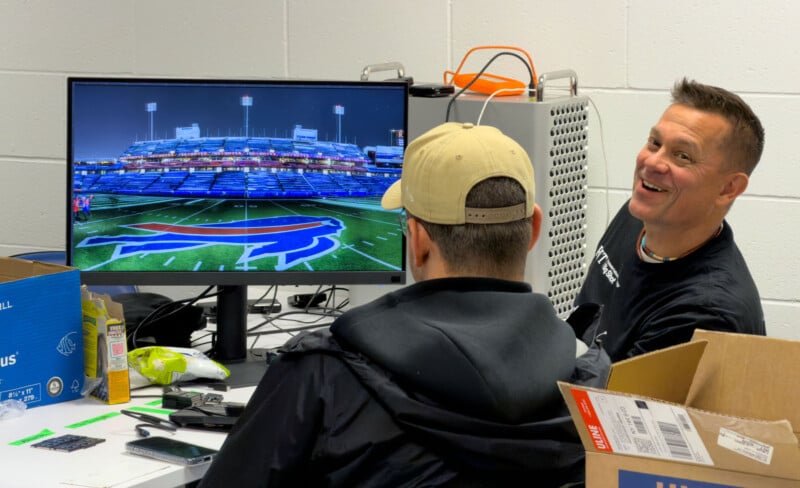
Professor Eric Kunsman, who is an exceptional photographer, led point on Big Shot 37 and tells PetaPixel that this year was particularly challenging.
“It was definitely the most stressful because of how we broke rules,” Kunsman says. “But I would actually say this one was also probably the most enjoyable in the end.”
A big part of why it was enjoyable was because it ultimately worked. It worked because months of planning went into the shot. The idea started forming back in February, and after months of back and forth, logistics, Nikon’s support, and working closely with the Buffalo Bills’ photographer, Ben Green, who was instrumental to the project coming together and was a massive help during planning and execution, it came time to capture the final image send Highmark Stadium out in style.
![]()
Anyone who has ever done family portraits or group shots of even just a dozen people knows firsthand how difficult it is to coordinate people for a photo. Now imagine coordinating not six people, but well over 6,000.
Kunsman and the team prepared instructional videos before the event to be played on the stadium’s jumbotrons, which were straightforward, helpful, and got all the attendees off on the right foot. RIT students and staff served as section leaders as well, helping keep their part of the field or their section of seats organized and ready for action. Finally, the fans themselves helped people who were confused and, occasionally, yelled out instructions in the dark: “Turn off your flashlight!”
By the time the fourth and final attempt had finished, the Big Shot team, which also includes Dan Hughes, Big Shot co-coordinator and lecturer in RIT’s School of Photographic Arts and Sciences, had perfected the exposure: 30 seconds of light in the stands, 60 seconds of lights on the stadium’s walls, and 150 seconds on the field because the black pellets in the artificial turf love soaking up all the light. Of the 6,000-plus people in the stands, maybe a handful left their lights on a second or two too long. That’s incredible coordination and speaks to people’s commitment to the project. Kunsman credits the operational smoothness to how excited people were to be part of something like this and to his team’s intricate planning.
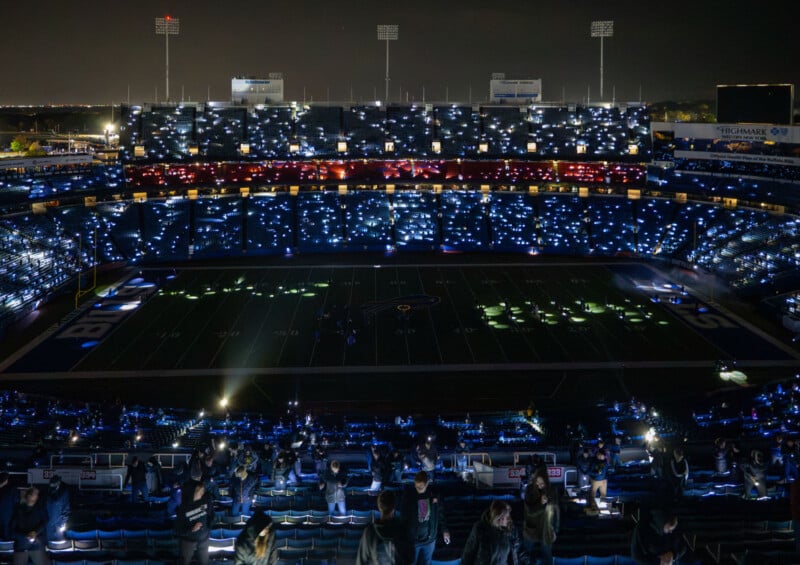
During the final shot, once people in the stands turned their lights off, they began drumming on the stadium’s seats.
“That was pretty freaking cool,” Kunsman says, who was stationed along with Hughes at the rig on the field. “That was not planned. That was all improv by the fans, and that was cool hearing that happening.”
Kunsman says the planning, which heavily ramped up in recent weeks, helped keep him calm. But once the instructional video started playing in the stadium and he saw his “big head on the jumbotron,” he began feeling the pressure.
“Are people going to understand this?” he worried. But they did.
![]()
Being Inside the Stadium
I arrived at Big Shot 37 at Highmark Stadium just after noon on Saturday, October 11, so I could see the setup, meet people like Kunsman and Hughes, and witness at least some of the immense work that went into making the event a success.
I told Kunsman later at CEPA Gallery in Buffalo, where Kunsman is on the board and where he made an over 10-foot-long print of the preliminary panorama in the early morning hours on Sunday, October 12, that he had seemed remarkably calm all day. He said this was mostly because of all the preparation that had gone into it and because of the support network he had, including his wife and kids who were there with him all day.
![]()
![]()
It turns out that it was not all smooth sailing, though. Kunsman realized that a bolt was missing for the rig when it was being assembled. As for where the missing bolt is now, nobody knows, but Todd Jokl, the Dean of RIT’s College of Art and Design, stepped in and rushed to Home Depot to get a replacement part. No harm, no foul. What could have been a significant stressor was quickly solved by an important part of the broader support network. Other little issues, like someone not knowing their assignment or not being able to track down a suitable tripod for an alternate view shot, were also resolved almost as quickly as they popped up.
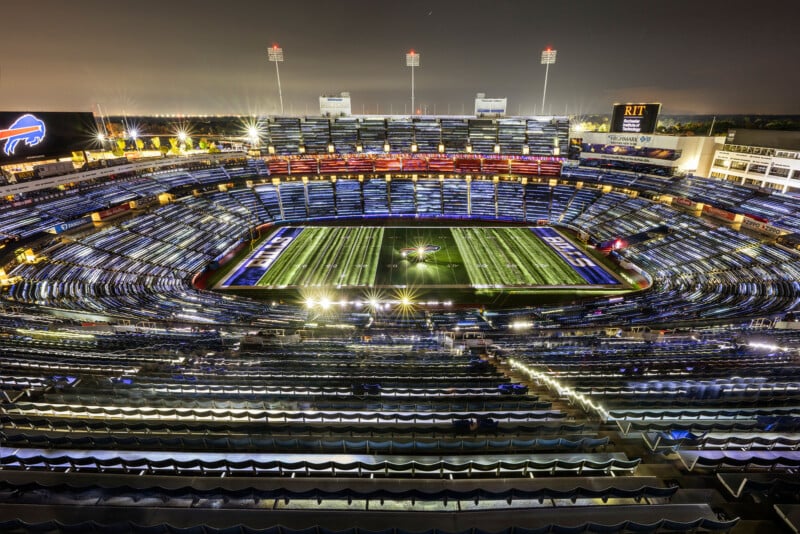
Speaking of the alternate views, that’s where I was stationed during the shooting that evening. Parked up on the 50-yard-line with a Nikon Professional Services (NPS) employee and a first-year RIT photojournalism student, Benjamin Lambrecht.
“I’m glad to have the opportunity to do something like this. It’s definitely an experience,” Lambrecht told me in between shots. “It’s very interesting, and I love to see how it comes together — something with people waving flashlights to come together to look that cool.”
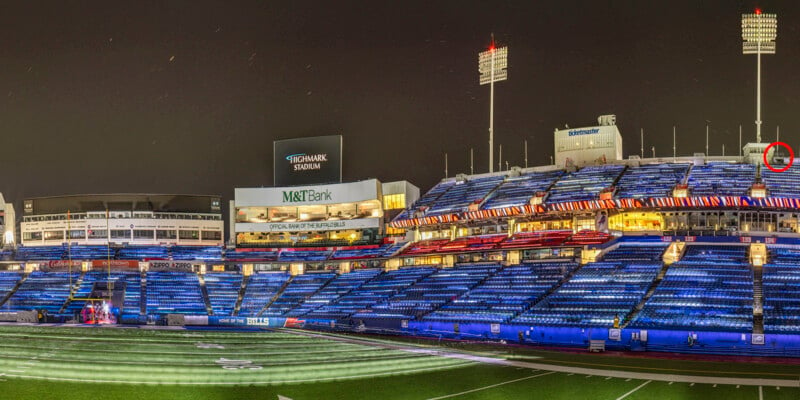
Lambrecht was one of six students who were stationed at different points above the last row of the stadium: two on either side of the 50-yard-line, and four in each of the stadium’s corners. They were all using Nikon Z9 cameras with different lenses to account for the various distances. Lambrecht had a Nikkor Z 14-24mm f/2.8 S.
The alternate view shots ended up being really fantastic, and one of the views even includes the new stadium being erected in the background, an imposing structure waiting for its time to help Bills fans make new memories. Kunsman notes that of these images, which will all be available for sale at the Bills team store, the one showing the new stadium in the background has generated the most interest so far.
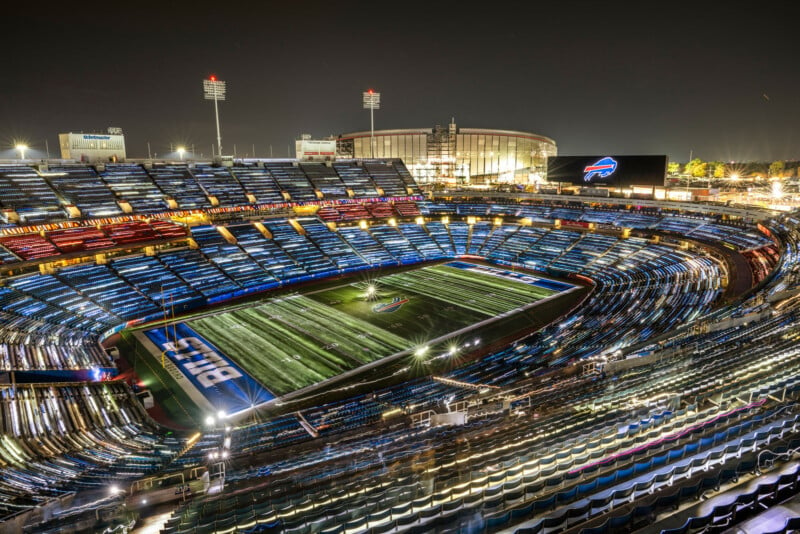
Being there and watching people filter into the stadium as the sun was setting, both literally and figuratively on Highmark Stadium itself, was quite powerful. Watching people come together and fulfill their roles for the photos themselves was even more impactful. You could feel the anticipation leading up to the first shot and the excitement everyone had when the stadium lights went off and the flashlights flicked on.
It was especially great to see so many families there with their kids, parents and grandparents forming new memories with their children and sharing a place that was so special to them for many years.
Nikon’s Role in Big Shot
Kunsman describes Nikon as much more than just a sponsor. While financial support is crucial for a project like this, Nikon’s role goes far beyond that.
“Right before their budget’s due, [Nikon] reaches out to us like, ‘Hey, what do you plan for this year?'” Kunsman says. “It’s not us going to them. It has truly become a collaboration.”
Kunsman says Nikon wants to know what the Big Shot team is doing and how they can best help. Beyond loaning RIT hundreds of thousands of dollars worth of camera equipment for Big Shot — and the school’s broader photographic education programs — Nikon also bought all the flashlights for Big Shot 37, which was no small feat given the number of attendees.
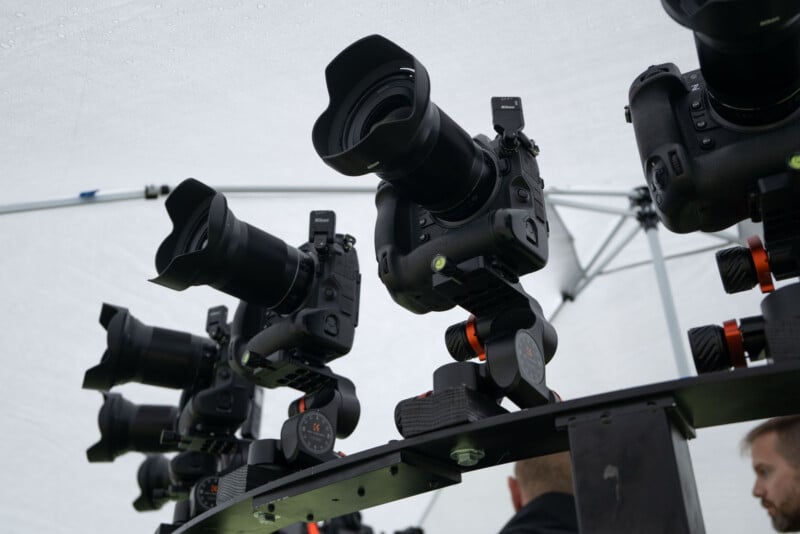
“They wanted to make sure we were taken care of. That’s how much of an investment Nikon has in it. It’s asking us what we need, what would make it easier,” Kunsman adds.
Nikon has been a Big Shot sponsor, partner, and collaborator since 2006 and sent three NPS employees up to Buffalo for this event, ready to provide on-the-ground support in real-time should anything go wrong with cameras or lenses.
“This is the biggest Big Shot I have ever seen, after working on this project for nearly two decades,” says Melissa DiBartolo, Senior Manager; NPS Operations and Strategic Engagement. “You could feel the immense energy when experiencing this massive event in person.”
“Nikon has been sponsoring The RIT Big Shot continuously, with support and equipment since No.22, which was in 2006. This year’s scale is unprecedented, with a 360-degree panoramic image produced from a custom array that mounted 24 Nikon Z9 cameras with matched Nikkor Z 20mm f/1.8 S lenses. And this year there were 6,500 participants!” DiBartolo continues.
![]()
She lauds Kunsman, Hughes, and the rest of the team for their increasingly sophisticated camera arrays and ambitions for the final shot.
“We consider it an honor to work so closely with The RIT Big Shot team, which is led by Eric Kunsman and Dan Hughes, who have spent countless hours behind the scenes leading up to this event,” DiBartolo says. “They have left no stone unturned, from all the event logistics, technical details, arranging complimentary ticketed access for the public, special kickoff parties, historical chats about the project with the RIT faculty founders, interactive stadium trivia, staging scenes within the image, and of course the main light painting event.”
RIT Big Shot is a particularly strong example of how creative minds can do incredible things using the latest photographic technology. Beyond the Nikon Z9 cameras and Nikkor Z lenses, Kunsman and Hughes also set up a sophisticated combination of Nikon wireless remote triggers and controllers.
“Nikon’s corporate philosophy of trustworthiness and creativity is perfectly paired with The RIT Big Shot. Nikon’s cameras and lenses are trusted to do their part, helping the RIT team’s vision comes to light (quite literally!) with their precise planning and execution. The scene in which the image is being captured to the participant is very different from what they see magically appear, in the end result. That’s another part of the creativity.”
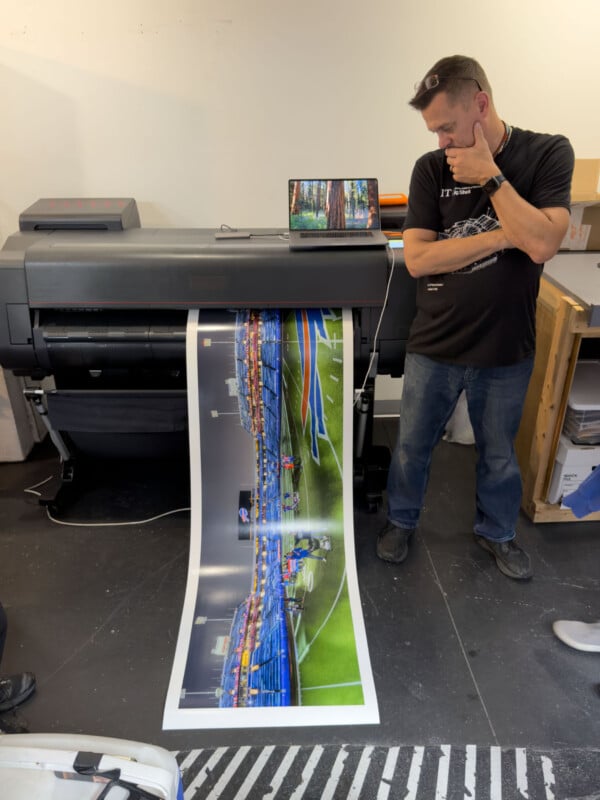
A Beautiful Panoramic Photo for the Community and By the Community
Photography is almost always a solitary activity. Even for those who take pictures of other people perform the act of picture making by themselves. RIT Big Shot has, since its beginning in 1987, been the complete opposite — it has been a community event.
What was originally created for the benefit of a small group of students has evolved into something much larger. Big Shot 37 at Highmark Stadium was a truly collaborative event, and I’m glad I could attend. It’s not often that I get to witness first-hand such a large group of people work together toward a common goal, and I’ve never seen anything like it when it comes to creating a photo.
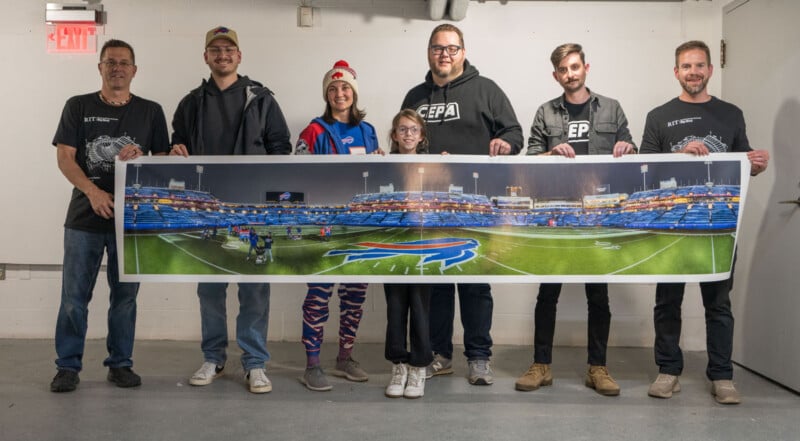
Every streak of light in the final, massive 24-shot 360° is a person who was there, doing their best. While it’s instrumental to give huge credit to Kunsman, Hughes, and the rest of the Big Shot team, plus Nikon and the other project partners, it’s fair to say that the final shot was made possible by every single person who showed up to participate in a truly special community photo event.

Once the Bills play their final home game this season, that will mark the end of the current Highmark Stadium’s life and the team will move across the road to “New Highmark Stadium.” Then the current stadium will be gone forever. RIT Big Shot 37 is not just a photo, and Highmark Stadium is not just a stadium. They are both so much more than that.
Image credits: RIT Big Shot. Additional photos by Jeremy Gray. RIT Big Shot 37 was sponsored by Nikon, Rochester Photo Supply, Hill + Valley Creative, and Mccrea Industries,